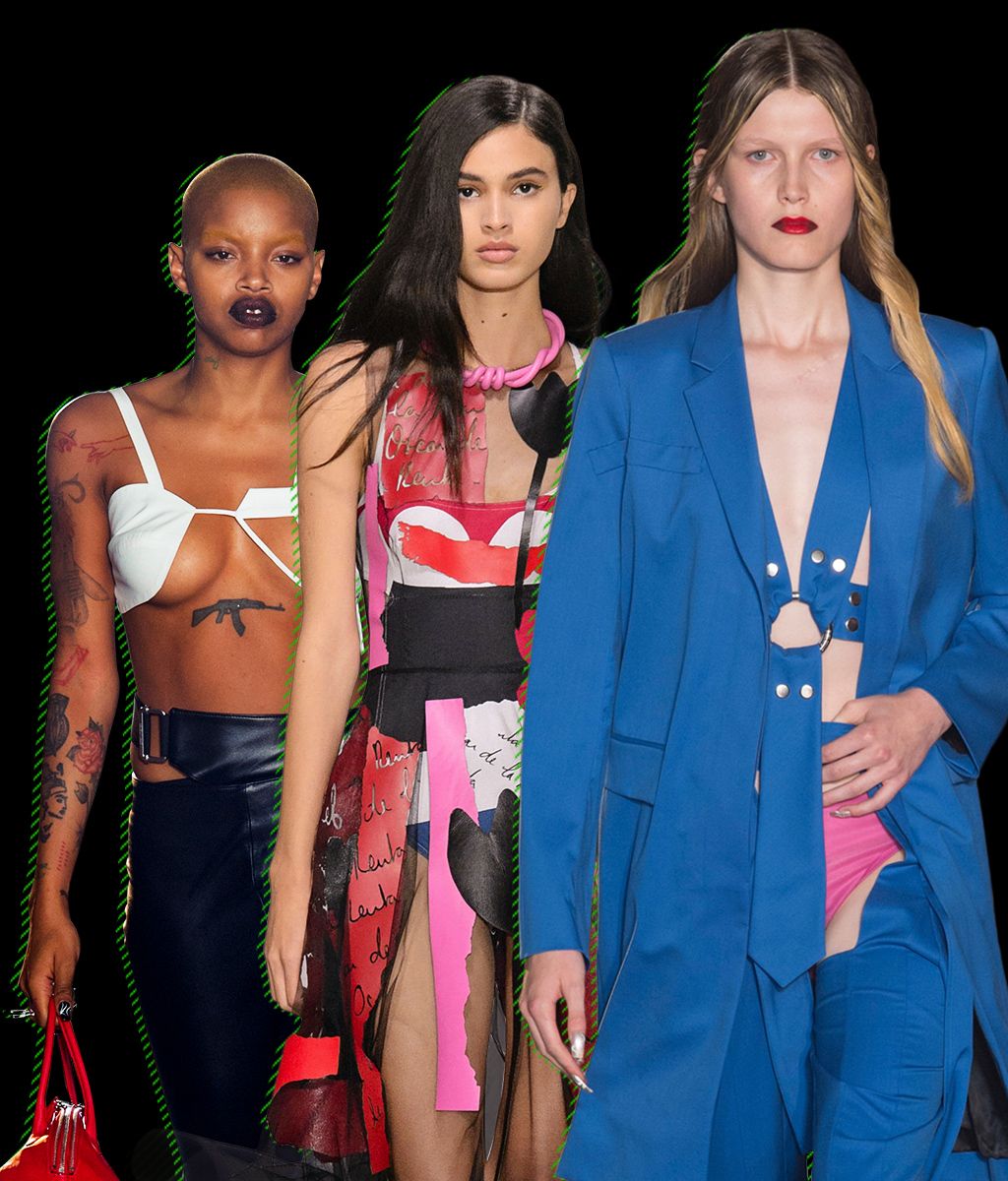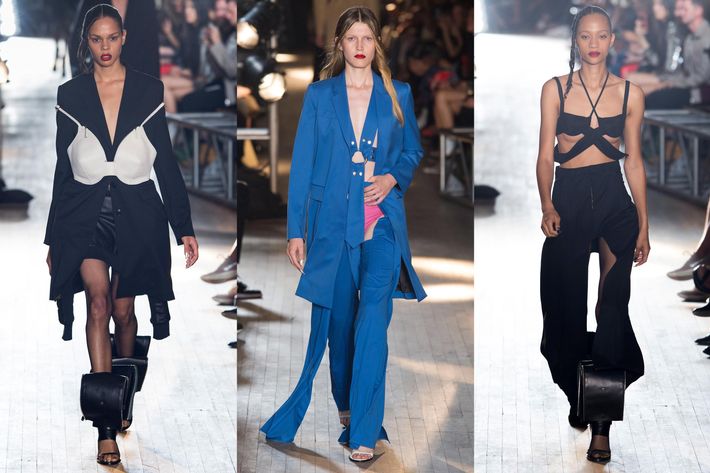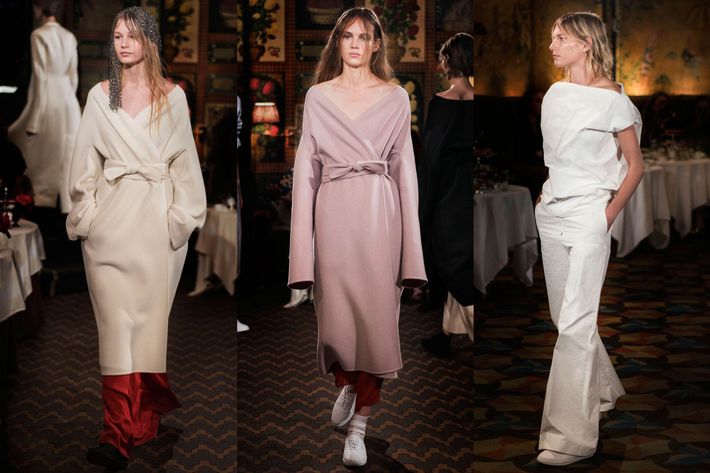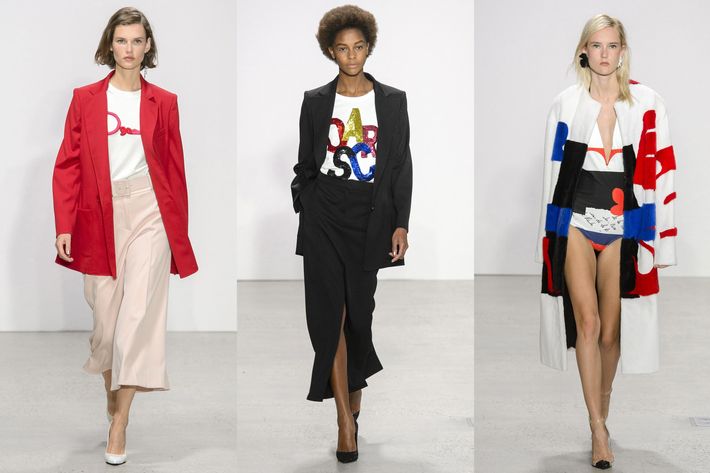The space for Shayne Oliver’s Helmut Lang show last night in Soho was the former Pearl River Mart on Broadway. You probably bought fish-patterned bowls there for your first apartment, or straw mats for the beach. The sidewalk was flooded with kids — most of whom know Oliver from his Hood by Air label — and the scene inside the block-long store was buzzy. In fact, it recalled other shows in Soho, but from the late ’80s and early ’90s — Marc Jacobs, Isaac Mizrahi’s debut in a loft, maybe a Stephen Sprouse show.
Lang, who is 61, left the business in 2005 and moved to Long Island, where he makes art. In the late ’80s, the Austrian’s minimalism seemed a response to the campy femininity of Thierry Mugler and Jean-Paul Gaultier. Small armies of editors and gallerists wore his tailored coats and trousers; Lang was also innovative with outerwear, and in the use of industrial materials like rubber. But perhaps the real force of his fashion was the sensuality it gave off. “It’s horny,” Oliver said in the Times the other day, speaking of Lang clothing with bondage-like straps. One of the qualities I admired in Lang (which he shared with Alaïa and Kawakubo) is that he refused to explain the source of his erotic gestures, if he even intended them to be erotic.
I remember sitting in his office in Vienna around 1997, and asking him about some semi-sheer dresses he had recently done that featured a kind of harness under the top of each dress. It made me think of a bra that had been hiked up above the boobs. Was that it, I asked Lang. He just smiled at me: no answer. I was free to see what I wanted to see.
Today, everything is overly interpreted and instantly consumed — whether it’s a dress or a photo of a destructive hurricane. For me, Oliver’s furious cutting style at Hood by Air, as well his intense, visually assaulting shows, is an attempt to reckon with the feelings that this culture produces, the splintering of historical codes and manners, the bombardment of images, the need to cut through things in order to, well, breathe.
I felt that sensitivity was present in his one-off Helmut Lang collection (which the company calls a “capsule,” though it included more than 50 looks with many accessories). And while one would have no trouble discerning Lang’s style in the trousers, masculine coats, and slinky tops, it was also clear that Oliver, who is 29, didn’t feel a need to pay respectful homage. He slashed into things, almost as if to disembowel the original (or the memory of the original), and he included small-fitting as well as jumbo bras. A white satin one, worn on the outside of a black jacket, seemed to dissolve both its intimacy and gender associations. It was just a starkly blown-up object that you could turn into a rain hat or a tote if you got desperate.
“I wanted to do the energy of Lang, rather than get into his clothes,” Oliver said afterward, adding that he hoped to convey sensuality with a dose of fetishism. Some people will find the sensuality very overdone, as if rendered with a blunt instrument. But, frankly, I’m not sure that Oliver could have handled this concept any differently. It’s how he sees things. He’s also of a generation that’s nervous and twitchy and always present. Lang, by contrast, seemed almost invisible. He certainly strived to be. And he had something — a singular aesthetic — which drew the world to him, and which still does.
Like many designers, Ashley and Mary-Kate Olsen owe a debt to Lang and other minimalists, notably Jil Sander, of the ’90s. (That decade is getting a good workout this week.) For their Row show at the Carlyle, the Olsens added a softness to their terrific fall collection — a long ivory coat that swept over a deep-red chiffon skirt and a beauty in pale-pink wool that dropped off the shoulders and had the brand’s signature extra-long sleeves. It brought to mind Paolo Roversi’s fashion portraits from the ’90s. The colors were fresh, as were crinkly white T-tops with trousers — and ubiquitous white tennis shoes.
After its founder’s death three years ago, Oscar de la Renta has now solidly entered a new phase. Co-designers Laura Kim and Fernando Garcia don’t have to second-guess their decision to leave behind Oscar’s ladylike suiting, tweeds, and big ballgowns, because they showed without a doubt on Monday that their way forward is more in touch with the times — younger and lighter in attitude and fabrics.
In just about every way, this collection (Kim and Garcia’s second) was superb. First, there were airy, slightly oversize blazers in stretch gabardine shown with cropped trousers and an embroidered logo T-shirt. The blazers also worked over beaded cocktail slips, and for a wonderfully streamlined evening suit in black stretch gabardine with a narrow slit skirt. It’s one of the best-looking evening styles of NYFW.
Second, the designers freshened up Oscar’s zesty palette with bright yellow paired with blush pink, red with shocking pink, and carnation pink with a white-cotton mini jumpsuit. They abstracted his handwritten logo and turned it into a broken collage for day dresses and black-net shifts over bathing suits. Finally, they brought the label’s fancy clothes up to date, mostly by relaxing the sense of glamour. The silhouette and craft of an evening dress still reads as de la Renta, but now it’s in delicate layers of bright dip-dyed pink tulle.






